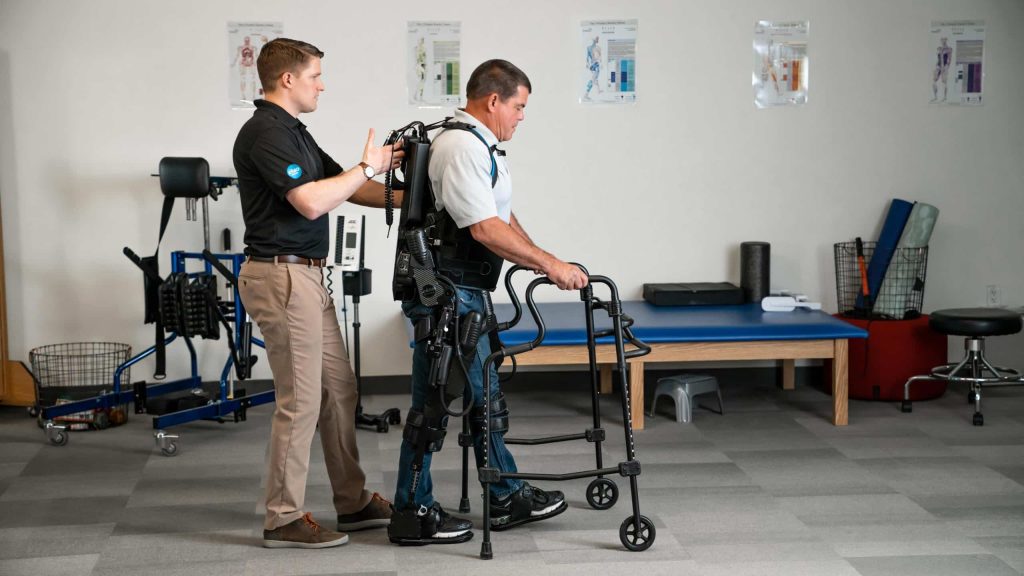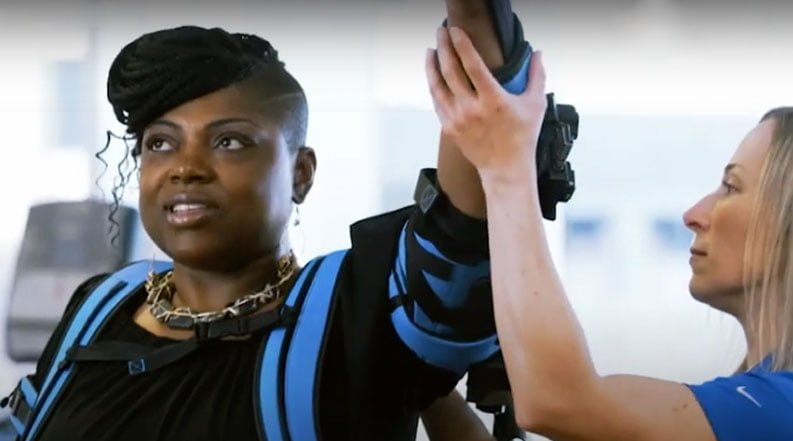Mobility: many of us take it for granted. But when you don’t have it, you realize just how lost, inadequate, and frustrated you feel.
People lose mobility due to many reasons, but stroke is a big one. Stroke is the top cause of serious long-term disability in this country, affecting 17 million Americans every year. More than one million survivors suffer functional limitations in daily activities as a result of their stroke, with more than 50 percent of stroke survivors having long-term walking impairment. Such impaired ambulation is associated with an increased risk of falls, limited social participation, and overall lower quality of life.
As many as 80 percent of stroke survivors have considerable gait deficits, including asymmetrical walking patterns and reduced walking speeds, thereby limiting their capacity for ambulation. Exoskeleton suits designed for mobility enhancement can correct these gait deficits. That’s a good thing, as nearly 40 percent of stroke survivors have moderate-to-severe impairments that require special care, while 10 percent more are admitted to long-term care or skilled nursing facilities and classified as unlikely to walk again.

Exoskeleton suits can also help individuals with spinal cord injuries gain some mobility, which could improve cardiovascular health, slow the loss of fat tissue, build lean muscle mass, improve bowel function, and aid in pain management. About 291,000 people in this country are living with spinal cord injuries at any one time.
For people who have experienced strokes and spinal cord injuries, it can certainly be tough to get around. But now, exoskeleton suits are helping these patients regain some of the mobility they have lost. Exoskeleton companies such as Ekso Bionics are paving the way for revolutionary advances in the rehabilitation field.
Helping With Mobility After Stroke
Exoskeletons give people who have had a stroke more opportunity to build up muscle strength and enhance range of motion. The long-term goal of rehabilitation is for the patient to be successfully reintegrated into the community, with recovery of walking ability as the top functional objective. This is achieved through task-specific, progressive, repetitive training based on the principles of motor learning. With targeted rehabilitation, the hope is to reorganize the brain to relearn skills that were lost as a result of the stroke.
Exoskeleton-assisted physical therapy is extremely promising for many people post-stroke. Tools such as these allow people to actively take part in their recovery while enjoying their life to the fullest.

Helping With Mobility After Spinal Cord Injury
Innovative devices such as those by exoskeleton companies like Ekso Bionics help individuals with spinal cord injuries gain some mobility when used in conjunction with physical therapy, training, and assistance from a caregiver.
One of the biggest benefits of an exoskeleton suit, of course, is that it allows people with paraplegia to walk again, having lost the brain function to do so. But this can come with many secondary effects as well. Being able to walk again is a huge stress relief for the individuals and their families. According to the Christopher and Dana Reeve Foundation, those who are paralyzed are 2 to 3 times as likely to develop depression as the non-disabled are, with the highest risk of suicide occurring withinthe first five years of diagnosis. Caregiver depression is a related illness that arises from the stress of taking care of a person with paraplegia.
What Ekso Bionics is Doing to Help
Ekso Bionics offers a wearable suit, called EksoNR, which was developed exclusively for use in rehabilitation centers and clinical settings to help patients gain back their mobility sooner. EksoNR is the first exoskeleton FDA-cleared for stroke, brain injury, and spinal cord injury, designed to ensure the most natural gait by re-teaching the brain and muscles how to properly walk again.
In addition to helping patients with stroke, it can also help patients with spinal cord injury, traumatic brain injury, aneurysm, hypoxia/anoxia, ischemia, and brain tumors.
EksoNR is currently being used in more than 270 rehabilitation centers around the world, under the guidance of trained personnel.
New technologies such as exosuits are increasingly making their way into rehab centers so that stroke and spinal cord injury patients can improve mobility.
Contact Ekso Bionics
To learn more about how robotic exoskeletons can aid in stroke mobility and rehabilitation, contact us at 510-984-1761.